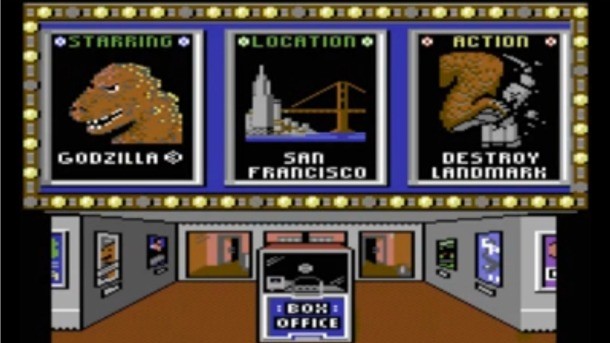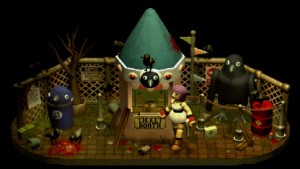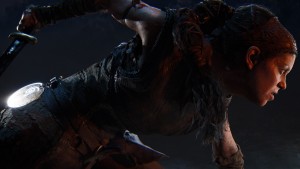Please support Game Informer. Print magazine subscriptions are less than $2 per issue
Godzilla’s Checkered Gaming Past: A Retrospective

With a new Godzilla video game out today on PlayStation 3 and 4, we thought it was the right time to revisit this feature from former intern Cameron Koch covering Godzilla's sometimes successful, often bizarre history in the world of video games. This piece was originally published on March 16, 2014.
While the poster boy for Japanese film company Toho continues to find success on film, the King of the Monsters’ video game past is a different story entirely. Like many other licensed properties, many developers have struggled to capture, or even identify, what makes Godzilla so enduring. The results are an extraordinarily mixed bag of strange gameplay mechanics and missed opportunities. From the Commodore 64 to now, we take a look at the Big G’s less than stellar gaming history.

Godzilla (Commodore 64)
Godzilla made his pixelated debut in 1983 with this simple strategy title. Using the military, you defend Tokyo from an attacking Godzilla. Highlighting portions of the grid tells you how many troops and civilians are in the given area and your military options for fighting Godzilla. Strangely, the atom bomb is the most powerful weapon in the game, capable of destroying Godzilla despite his origin as a creature created from nuclear fallout.

The Movie Monster Game (Commodore 64, Apple II)
This appropriately titled game from 1986 lets players pick look-alike versions of iconic movie monsters such as The Blob and even the Stay-Puft Marshmallow Man from Ghostbusters before stomping around various real-world cities (complete with iconic landmarks.) Developer Epyx managed to obtain the rights to use Godzilla in the game, making him the only “real” playable movie monster to make an appearance. As a result, Godzilla adorns the game’s box art, where he can be seen destroying the iconic Tokyo Tower.

Godzilla: Monster of Monsters (NES)
In Monster of Monsters players take control of either Godzilla or fellow Toho monster Mothra as they fight across space to defeat aliens intent on conquering Earth. You first move your character on a chess-like board before playing through a side-scrolling level set on various planets. Jets, alien creatures, and various obstacles stand in your path, requiring you to duck, jump, and punch your way to the end of the stage. Once you complete a stage, computer-controlled boss monsters on the other end of the board take their turn. Moving to a space adjacent to a boss lets you fight them in a 1v1 battle similar to a fighting game.
The only problem here is a time limit that isn’t shown to the player; take too long and you will be booted back to the board without warning, where you can then choose to fight the boss again. This annoyance is made even worse by the fact that the boss monsters regain some of their life, while your character doesn’t. Every board requires you clear an increasing number of boss monsters, and the game quickly becomes difficult. If Monster of Monsters is remembered for anything, it is more likely to be the game’s catchy music rather than its mediocre gameplay.
| Best Godzilla Games Not Starring Godzilla |
|
Out of the Big G’s dozen-plus video games, only a select few are worth recommending to anyone who isn’t a kaiju groupie. However, some of Godzilla’s best games are ones not directly starring the King of the Monsters but instead heavily influenced by him. The iconic 1986 arcade game Rampage and its many sequels feature the Godzilla-like monster Lizzie for players to destroy cities as, along with the King Kong-inspired George and the giant werewolf, Ralph. Arcade title King of the Monsters and its many ports also took inspiration from Godzilla and other giant monster films, pitting players against one another in city-sized wrestling arenas. Another is the criminally underrated fighting game War of the Monsters, released for the PlayStation 2 in 2003. The game is one big homage to giant monster films of the ‘50s and ‘60s, and features creatures inspired by classic films of the genre, Godzilla included. |

Godzilla (Game Boy)
Following his NES debut, Godzilla found himself shrunk down onto Nintendo’s popular handheld. The King of the Monsters has never looked cuter. Godzilla for the Game Boy is a puzzle game where you play as a chibi version of Godzilla who must destroy all the boulders on a given stage by pushing them up against a wall and punching them, all in search of your son, Minilla. It’s kind of like the block puzzles in Legend of Zelda dungeons, but with little chibi versions of classic Godzilla villains trying to stop you. You climb up ladders and vines in order to push boulders in just the right way to succeed. It’s not a bad game, but it does almost nothing with the license other than including cutesy versions of Toho’s iconic monsters.

Godzilla 2: War of the Monsters (NES)
A sequel to Monster of Monsters, Godzilla 2 had the potential to refine some of the frustrating and confusing elements of the first game and improve upon it. Instead, players were treated to a completely different genre of gameplay more akin to the Commodore 64 Godzilla. Rather than a side-scrolling action game, players once again control the military as they attempt to fend off monster attacks by moving tanks and jets around the map in what can loosely be compared to a turn-based strategy game.
The concept could work, except nobody is playing a Godzilla game to play as the helpless military. Godzilla is about feeling powerful, and this game does anything but. To make matters worse, the outcomes of battles between your units and monsters are determined by a slot machine system, throwing strategy and tactics out the window. At this point Godzilla games couldn’t get any worse, but they could definitely get stranger.
Click on to page 2 for Godzilla's bizarre Super Nintendo debut and the games spawned from America's first Godzilla reboot.

Godzilla a.k.a Godzilla: Battle Legends (TurboDuo)
Godzilla would finally get a game (simply titled Godzilla in America but known as Battle Legends in Japan) worth being excited about in 1993. A 2D fighter, this title finally managed to deliver solid gameplay and captured a core aspect of the franchise that numerous other developers had somehow missed: Two monsters beating the crap out of each other. One cool feature for long-time fans of the Godzilla films was the inclusion of multiple looks for Godzilla. According to which enemy monster you fight, Godzilla’s design changes to match his film counterpart. Fight Anguirus and Godzilla appears as he did in the 1955 film Godzilla Raids Again, while fighting Mecha-King Ghidorah changes Godzilla’s look to match that of his 1991 appearance. Many of the game’s stages are pulled straight from the films as well. Unfortunately the game was released on the TurboDuo, a console released in 1992 that lived in the shadow of Sega and Nintendo's consoles. As a result few gamers, myself included, ever had the chance to play.

Super Godzilla (SNES)
If you are wondering how strange Godzilla games can get, look no further. For 80 percent of your time in Super Godzilla, you play as a blue dot. That blue dot represents Godzilla, and you move him around a 2D map. Grey squares on the map are buildings. Green squares are tanks. A pink dot is the boss monster for the stage. When you find your pink nemesis, the game turns even stranger, replacing the top-down map gameplay for one of the most bizarre fighting game systems ever conceived. Controlling Godzilla, you must move your character forward to punch the enemy monster and quickly back up. This opens up an “Attack Window.” The further you pull Godzilla back, the more powerful attacks he can use. Upon selecting an attack, a stylized cutscene shows Godzilla firing off his selected attack and his opponent taking damage. Rinse and repeat.
Despite numerous shortcomings, fans have found two bright spots in the game. The first is the game’s namesake, a powerful new version of Godzilla obtained late in the game that looks similar to designs Toho would use for Space Godzilla. The other is the game’s final boss, Bagan. Bagan was originally designed to appear in multiple Godzilla films, but instead only appeared in this forgettable title.
A New Beginning
Being a Japanese creation, a number of Godzilla titles were released in Japan only. The Super Famicom sequel to Battle Legends would sadly be Japan only, and two Dreamcast Godzilla titles would also never make it stateside. It would be several years before another Godzilla game emerged from the depths in America, but when it did, it wasn’t the Godzilla fans had come to love.

Godzilla: The Series (Game Boy Color)
In 1998, Hollywood got its first shot at re-imagining Godzilla for an American audience. Set in New York, this new Godzilla looked more like an oversized iguana than a radioactive city smasher. Though the film let down many fans, an animated series created as a sequel to the movie won over some viewers by adopting a Godzilla vs. monster of the week format similar to that of the old films. The series spawned two poorly received side-scrolling shooters for the Game Boy Color, one simply titled Godzilla: The Series and another called Godzilla: The Series Monster Wars. In both games Godzilla automatically walks forward, and the player is responsible for dodging projectiles while shooting tiny blasts of fire out of Godzilla’s mouth. Not Godzilla’s finest moment.

Godzilla: Destroy All Monsters Melee (GameCube, Xbox) Godzilla: Save The Earth (Xbox, PS2) Godzilla: Unleashed (Wii, PS2)
A trilogy of 3D fighters released between 2002 and 2007 finally proved making a fun Godzilla game was, in fact, possible. The first was Godzilla: Destroy All Monsters Melee, a timed exclusive for the GameCube that eventually made its way to the Xbox and also received a Game Boy Advance version called Godzilla: Domination. This was the game Godzilla fans had long waited for, with destructible cities, a sizable roster of Godzilla’s rivals, and impressive visuals for the time. Most importantly, the game supported four controllers, meaning you and three of your friends could duke it out for some hilarious monster mayhem.
The game’s sequel, Godzilla: Save The Earth, expanded upon the formula by adding even more monsters and online multiplayer. Last and least came Godzilla: Unleashed. In many ways identical to Destroy All Monsters Melee and Save The Earth, Unleashed brought down the trilogy of games with poor graphics and unresponsive controls. All three games suffered from a lack of compelling single-player content and received their fair share of criticism from the gaming press, but for many Godzilla fans a solid 3D fighter was more than adequate after years of disappointment.

The Future
It seemed for a long time that a new Godzilla film would never see the light of day, much less a video game. But that has changed with the new American reboot. A free-to-download, match-three puzzle game based on the upcoming film will be Godzilla’s first game since Unleashed in 2007, and is being developed by the same studio behind the Destroy All Monsters trilogy, Pipeworks Software. A match-three game seems like a strange framework for the world’s most well-known monster, but with a video game past like Godzilla’s, it doesn’t seem so out of place.










